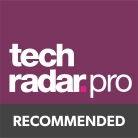TechRadar Verdict
The WorkForce Pro WF-4630 is a solid printer for small businesses and workgroups given its fast print speeds, solid print qualities and remote printing and scanning capabilities. Using the larger XL print cartridges, the WF-4630 delivers economical print costs that rival laser printers.
Pros
- +
Fast print speeds
- +
Cloud-connected
- +
Remote print
- +
Economical print costs
Cons
- -
Loud
- -
Uninspiring design
Why you can trust TechRadar
The Epson WorkForce Pro WF-4630 is a versatile all-in-one inkjet printer that delivers excellent value for money and produces economical color and black-and-white prints.
In fact, Epson says its PrecisionCore inkjet technology produces superior prints at less cost than a comparable laser-based rivals.
Priced at $200 (£130, AU$253), the WF-4630 swims in the same pool an business-centric multifunction inkjet printers like the Canon Maxify MB5320 ($399, £260, AU$505) and the HP OfficeJet Pro X551dw ($300, £200, AU$380).
Its quality means it also competes with smaller multifunction color laser printers, like HP's Color LaserJet Pro MFP M277dw ($429, £280, AU$544) and Samsung's Multifunction Printer Xpress C1860FW ($224, £145, AU$285).
Note: the WorkForce Pro WF-4630 is currently no longer available directly from Epson, however a number of third-party retailers still offer it online - full details below.
Design
Weighing 31.3 pounds (14.20kg) and measuring 18.1 inches across by 25.8 inches deep and 15.1 inches tall (46.0 x 65.5 x 38.4cm), the Epson WorkForce Pro WF-4630 isn't huge, but it's large enough that you'd want to place it on a dedicated printer stand or table for use in a shared workgroup. As a personal printer, however, the large, boxy and utilitarian design takes up precious desk real estate, and its presence could feel overwhelming on smaller desks.
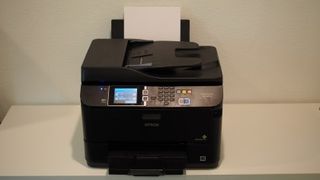
Like many Epson printers, the WF-4630 has an understated design that works well in business environments, with a matte black plastic body and glossy black trims. Most of your interaction with the WF-5630 will be handled through the 3.5-inch touchscreen panel. Thankfully, the touchscreen is easy to use with intuitive menus.
The user control panel at the top also houses hardware buttons for the fax dial pad as well as quick copy buttons for color or black-and-white copies.
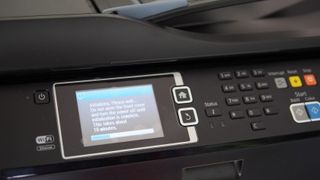
Compared to the touchscreen-driven interface of the competing HP OfficeJet Pro X series, the presence of physical buttons on the Epson makes the WorkForce Pro WF-4630 instantly feel like an office tool.
The WF-4630 doesn't have an SD card slot, but a USB port is conveniently located on the front for direct USB printing or saving scanned files to a flash drive. Additionally, the printer supports printing and scanning using Wi-Fi from a PC, Mac or smartphone running Android or iOS.
At the top of the printer is a 35-sheet automatic document feeder, which can be used for duplex scanning and copying, saving you time since you don't have to manually scan each side of a document. This feature can be used for printing, copying and faxing two-sided, multi-page originals. Alternatively, lifting up the automatic document feeder reveals a flatbed scanner for more manual control.
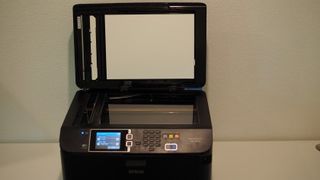
The WF-4630 has a single 250-sheet document tray on the bottom, and a rear, top-feed on the back accommodates 80 sheets. If you max out both trays, the printer has a maximum capacity of 330 sheets.
In my setup, I have letter-sized paper in the document tray, and I used the rear feed for special one-off print jobs - like for envelopes, labels or for special photo jobs that require more expensive photo paper.
Users who need two document trays should look at the WF-4640, a printer that's based on the WF-4630 but comes with two document trays and a rear feeder for a maximum paper capacity of 580 sheets.
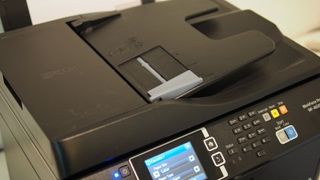
The WF-4630 document tray can handle various paper sizes, up to a maximum of 8.5 x 14-inch sheets. Using the rear feed, the printer can handle 8.5 x 47.2-inch paper prints.
Similar to rival HP's PageWide print technology, Epson's PrecisionCore increases print speed and quality by increasing the density of the print nozzles. The PrecisionCore print chip on the WF-4630 contains about 800 nozzles per chip, which is roughly 600 nozzles per inch.
PrecisionCore also decreases the size of each ink dot that's printed, and Epson also widens the printhead. Epson claims that this allows the print head to deliver better control of ink flow, more density of ink dots for better print quality and faster print times.
The setup process begins when users open the front hatch of the printer to insert the four different ink cartridges into the left side for cyan, magenta, yellow and black inks. The WF-4630 ships with standard-sized cartridges.
I found the initial setup process to be relatively simple. The touchscreen display on the WF-4630 shows where the printer is during the process.

Overall, it took me about twenty minutes to get the WorkForce Pro WF-4630 started. The bulk of the that time is used by the printer to calibrate the printhead. You won't need to do much intervention until the calibration is complete, and I found the WF-4630 generated a variety of different noises during this process.
After the calibration was completed, I downloaded the appropriate software and drivers to both my Mac and my PC on Epson's website, connected the WF-4630 to my home router using WPS, and was able to begin printing and scanning wirelessly in less than ten minutes. The software setup process was similar on both a Mac and a PC.
The entire setup is rather lengthy, but you'll only need to do that once. Once attached to a router or modem, the WF-4630 will provide you with its IP address, and you can even send documents wirelessly to the printer even if your device isn't on the same home network.
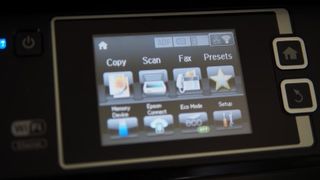
For business executives, this Remote Print feature will be valuable, as you can research information on the road and print from wherever you are.
In the past, I would review emails and documents at lunch, noting in my head what I should print later only to forget to print what I need when I return to my desk. This is no longer the case with the IP-connected Remote Print feature, as I can review and print work documents when I am on the road and have my prints waiting for me when I return to the office.
Print costs
Epson's $22.99 standard-sized cartridges are rated for 900 pages of printing, equating to a cost of 2.6 cents for black-and-white prints and 11.6 cents for color.
The larger capacity XL cartridges have a higher up-front investment at $41.99 for black and $43.99 for each color, but provide more economical output. The black cartridge yields 2,600 prints while Epson rates the color cartridges for 2,000 prints. This lowers the per-page cost to around 1.6 cents for black-and-white documents and 8.2 cents for color pages.
Print costs are more expensive than the HP Officejet Pro x551dw ($299, £200, AU$380), which provides a per page cost of 1.3 cents for black-and-white and 6.1 cents for color jobs. HP's printer requires a larger initial up-front investment, but comes with a more modern design with sleek lines and artful cutouts.
The WF-4630 is a fast inkjet printer, and its print speeds rival many mid-sized office laser printers on the market today. Print speeds for the WF-4630 are comparable to HP's Color LaserJet Pro MFP M277dw. This makes the WF-4630 an attractive printer for offices that are dependent on high volume printing.
I was able to print a five-page black-and-white PDF in less than twenty seconds from my Mac over my home Wi-Fi network. After I hit the print button on my laptop, it took about five seconds for the printer to warm up, and between two and three seconds for each page to print.
My print speeds matched Epson's claims of roughly twenty pages per minute for both black-and-white and color print jobs. Epson says the WF-4630 is capable of producing 11 pages of black-and-white or color pages per minute of duplex or double-sided prints.
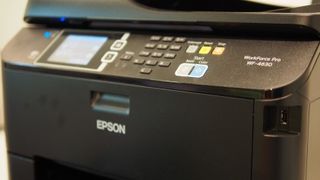
More complex print jobs take a bit longer to complete, but the WF-4630 was able to handle JPEG photos, Microsoft Word documents, Excel spreadsheets and graphs, PowerPoint presentations and more with impressive speeds. The WF-4630 is one of the faster small workgroup printers on the market today.
Although print speeds are admirable, the WF-4630 is only half as fast as the HP Officejet Pro x576dw ($399, £265, AU$510). HP claims that the Officejet can deliver black-and-white and color print jobs at speeds up to 42 pages per minute. In general office mode, the Officejet Pro x576dw is even faster, with speeds up to 70 pages per minute.
For office documents, I found the resulting print quality just as impressive as the WF-4630's print speeds. Text, charts and diagrams look sharp on prints produced on the WF-4630, and I couldn't spot the difference between a print from the WF-4630 or from a mid-range laserjet.

I found the ink to be well-controlled on the WF-4630. On consumer inkjets, printing a document with a solid patch of color or having white text over a color background would result in a page that feels wet when it comes out. Additionally, the paper also gets slightly warped with the excess liquid from the heavy use of ink. This isn't the case on the WF-4630.
Using standard 20-pound weight office copy paper, I found the WF-4630 does a good job at controlling ink flow. In a print job where there is white text over a solid patch of color background, I noticed that the paper remains crisp and not warped, a situation that I noticed with more inexpensive home printers due to excessive ink use.
With quick drying ink, I also noticed that prints do not smudge, even after I spilled half a glass of water over a printed document within seconds of removing it from the printer.
Photo printing
Print speeds for photo printing is less impressive with the WF-4630, which isn't surprising given that Epson tuned the printer for office jobs. I found the WF-4630 is capable of producing a 4 x 6 print in as little as 30 seconds.
Photo quality will suffice for small projects and for home and casual use. Discerning photographers and those needing prints larger than 8.5 x 11 inches would likely need to turn to a photo or studio printer.
The WF-4630 produces prints with a maximum resolution of 4,800 x 1,200 dpi. At this resolution, photo professionals may not be able to achieve the high dynamic range for color prints that they seek.
There are higher resolution printers on the market today, like the Canon Pixma MG7520 ($130, £85, AU$165), which comes with a dpi of 9,600 X 2,400, and the consumer quality Epson XP-420 ($79, £52, AU$100), which comes with a dpi of 5,760 x 1,440. For small offices, the dpi output of the WF-4630 will be more than sufficient, and those users will likely appreciate the flexibility of a multifunction network printer over an extremely high dpi.
If you're satisfied with the resulting image quality, you'll be happy to know that your prints are rated as smudge, fade, and water resistant with Epson's DURABrite Ultra pigment inks. The prints are said to be fade resistant for up to 118 years.
Copying and scanning
There is a lot of flexibility on where to save and store scanned images from the WF-4630. Using the touchscreen controller, I was able to choose where I wanted my scans to be saved, whether that's on a USB drive that's plugged into the front USB port, to my Mac or PC connected to my Wi-Fi network, to an iPhone or Android smartphone, or to the cloud using Epson Connect.
Scanning wirelessly to a device on the same Wi-Fi network is easy. On the touchscreen, you'll choose the Document Capture Pro option, and then choose from a list of PCs on the network where you want your files sent.
You can also choose to scan to a memory device and plug in a flash drive.
And if you're using the WF-4630 as a personal printer, you can also initiate a scan from a nearby laptop or PC using the downloaded software from Epson's site. With this method, your printer can either be connected to the same Wi-Fi network or over USB to your computer.
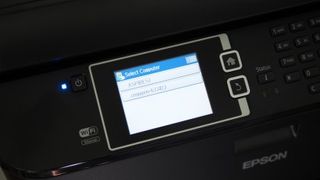
Another option is scanning using Epson Connect. Similar to how Remote Print enables users outside of their Wi-Fi network to send print jobs to the printer, Epson Connect handles scans, with options for scans to be emailed to designated email addresses or uploaded to a cloud service like Google Drive, Dropbox, Box, or Evernote.
Executives who are out of the office and need to have documents scanned can instruct their team, colleagues or assistant to use Epson Connect to scan and upload or email the files directly from the printer without requiring a PC. This saves time and requires fewer steps than having to send the files to a PC, and then uploading those documents from a computer.
Epson Connect is similar to Canon's Maxify Cloud Link and HP's ePrint service. Canon's Maxify Cloud Link for the company's line of Maxify business multifunction printers offers integration with the same cloud storage services as Epson Connect.
To use Epson Connect, you'll need to download the software to your PC or Mac. Once installed, your computer needs to be on the same Wi-Fi network as your printer for the initial setup. You'll also need to enter an email address and create a password to manage the printer. I found the whole process to be straightforward.
After the software is installed, logging into the web portal on a browser allows you to add email addresses and cloud service accounts. Once you do that, these accounts will be available as options on the printer, allowing you to scan to the cloud.
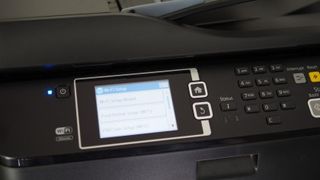
I tested Epson Connect remote scanning capability with Google Drive and Gmail. I had no problems with either method - the scanned digital files were automatically uploaded from the printer to my Google Drive storage or sent as an email attach to my Gmail inbox.
The scanner has a resolution of 2400 dpi, with a hardware resolution of 2,100 x 2,400 dpi. The scanner has a 48-bit color depth and can generate files with 24-bit.
For copies, the speed is about 19 pages per minute. In my tests, I got about 17 to 18 pages per minute for single-sided copies. Using the touchscreen, I was able to choose various copy options, including single-sided or double-sided inputs and outputs, and copies removed the appearance of punched holes and shadows. I can also preview copies, adjust the size and choose an option that optimizes copies of ID cards.
The Epson WorkForce Pro WF-4630 delivers affordable and reliable color and black-and-white prints on or off your office's Wi-Fi network. With print costs as low as 1.6 cents for black-and-white prints and 8.6 cents for color prints with XL print cartridges, Epson's claim of delivering value "beyond laser" holds true.
We liked
The WorkForce Pro WF-4630 delivers quality prints, economical costs and fast printing speeds. There's a lot to love about this multifunction printer - it superbly handles office print jobs, and print quality rivals those of color laser printers.
The automatic document feeder can handle double-sided scans and copies, and a specialty rear paper tray offers added convenience to the front-loading 250-sheet tray.
Epson Connect is a useful feature for remote printing and scanning when you're off of the office Wi-Fi network, and the touchscreen offers intuitive menus and control. Even though the presence of a physical dial pad for the fax machine makes the machine seem dated compared to HP's all-touch controls, the WF-3630 has hardware buttons to quickly make color and black-and-white copies without having to dig into the touchscreen menus.
We disliked
With a more utilitarian and boxy design, the Epson WorkForce Pro WF-4630 isn't quite as sleek or modern as rival HP's OfficeJet Pro X series. Although you may have to invest in a higher up-front cost for HP's printer hardware, the cost per page is lower with HP's printers, meaning you'll save money in the long run if your office has high print volumes.
Office users may want to upgrade to the WF-4640 model to have a second front-loading paper tray so that they won't have to refill on paper too often.
If you're okay with Epson's understated design, the only big fault that comes to mind with the WF-4630 is the odd sounds it makes when warming up and printing. Though the sounds aren't overly noisy, the WF-4630 isn't quite as quiet as a laser printer. The sounds that the printer emits are unique, and when the printer is warming up or cooling down, it sounds louder than an Epson home printer.
Final verdict
Unless your office requires heavy photo print jobs, the WF-4630 is an excellent choice. It's versatile enough to handle office documents with fast print speeds that rival laser printers, and you won't be disappointed with the results either.
Executives who work remotely can send their print jobs to the printer from outside the network with remote printing, a solution that saves time and ensures that you won't forget to print all the important documents. Automatic cloud scanning from the printer also saves time for backing up scanned documents.
Low per-page print costs and an affordable printer price should make the WF-4630 a top contender for your small office printer.

The 10 best laptops of CES 2025: from the Lenovo ThinkBook Rollable to the Razer Blade 16
Australian Open LIVE: tennis stream, cheapest deals, schedule, watch every match online, draw

I am thrilled by Nvidia’s cute petaflop mini PC wonder, and it’s time for Jensen’s law: it takes 100 months to get equal AI performance for 1/25th of the cost

